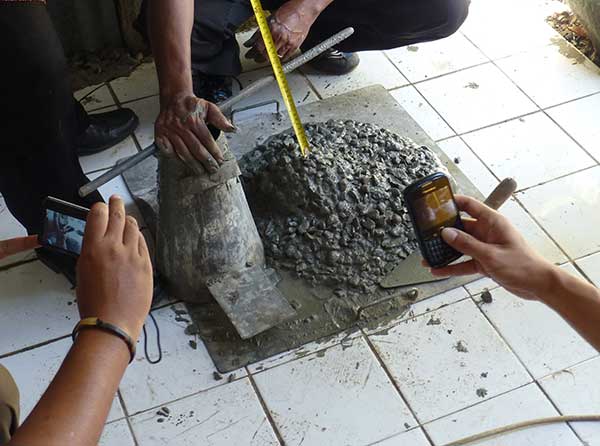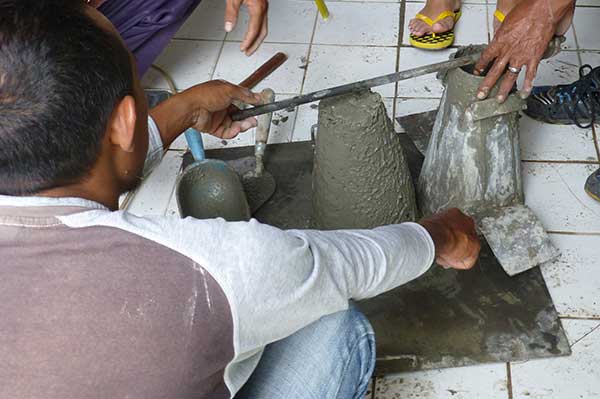Concrete Mixtures and Structural Strength
Concrete mix Ratios and Strength
Concrete is the single most important component to building and construction and is used all over the world for construction of anything from buildings, roads, harbours, bridges, the lost goes on and on.
What is concrete? The mixture of concrete is very important to make sure it is strong enough.
Here we look at the mixture of concrete and how it affects the strength. To check the mixture we use a slump test and a hardness test.

What is concrete?
Concrete is the single most importnat component to building and construction and is used all over the world for construction of anything from buildings, roads, harbours, bridges, the lost goes on and on.
Cement is, of course, a binder that holds masonry together made from crushing fired limestone into power.
When mixed with sand and water you get mortar which is used for bonding bricks, concrete blocks or other masonry components together.
If you mix cement with course gravel aggregate (pieces of broken stone), sand and water you get concrete, undoubtably the most commonly used building material in the world today. Concrete is very useful stuff because it is poured into place as a thick slurry or sludge but sets like stone. It is incredibly flexible and can be used to create complex shapes as single masonry components.
Portland Cement - some history
When cement was first discovered or by whom is not known but it is known that the ancient Macedonians were making concrete using a binder made from burned lime several hundred years before christ. Three centuries later the Romans used lime based concrete extensively for aqueducts and bridges and other buildings.
After the fall of the Roman Empire there was not a great deal of development of concrete for the odd millennium or so but then in the 19th century when the industrial revolution came along cutting stone for building was all a bit too expensive so people starting burning mixtures of clay and chalk to make new types of lime based cements.
A few false starts produced several different recipes but eventually a chappie called Isaac Johnson developed the production technique for Portland Cement which takes it name from its similarity to a white stone from Portland in Dorset. Patented in 1824 Portland cement is made by heating limestone with some other additives including clay in a kiln to a temperature of 1,450 degrees. Limestone is calcium carbonate and when it is heated it gives off carbon dioxide leaving calcium oxide which is better known as quicklime. It cools as a “clinker” which is then ground to a powder and mixed with a small amount of gypsum to give you what has become the most popular of the cements we use today.
When cement is mixed with water there is chemical reaction known as hydration. As the cement sets it slowly absorbs carbon dioxide and forms calcium carbonate again. Interlocking crystals in the structure of the cement gives it considerable strength.
Now we add sand and some small rocks (aggregate) and we have concrete.
A typical concrete will set in around 6 hours, it will have started gaining strength by 24 hours and continues to gain strength of the following months and years particularly if it is kept wet. The gypsum slows down the reaction to give time to place the concrete or mortar before it starts setting.
If you want a strong building the concrete mix is very important
Enough of the background let’s get to the important stuff. Mixing concrete is rather like baking a cake. You have to have the correct ratio of ingredients or instead of fruit cake you're likely to end up with gravy.
Very relevant when building a house in an industrial environment where any opportunity to save a bit of money will be exploited it is important that there is enough cement in the mix to fill the voids and bond the sand and aggregate together. Unfortunately with cement costing considerably more than sand there is a tendency for builders to use as little sand as they dare to save money. As a result many buildings in Indonesia are weaker than they were designed to be.
This cannot be better demonstrated than in the disaster of the 2006 Yogya earthquake in which 135,000 houses either fell down or were badly damaged. Mortar holding the bricks together that made up the walls of many of these houses had as little as only 1 part cement to 10 parts of sand. It is generally understood that to make effective mortar 1 part of cement should be mixed with only 2 or 3 parts of sand.
The mixture for concrete is generally recognised to be 3 parts of aggregate to 2 parts of sand and 1 part of cement.
It is obvious that the mixture of cement, sand and aggregate is very important but there is another ingredient in concrete which is just as important as the others ¯ water.
Too much water weakens concrete
The amount of water used is critical and determines how strong the concrete will be. Next time you see a builder’s labour mixing mortar or concrete you will probably find that they will haphazardly throw a sort of mixture together and slosh in some water. Often you may notice they finish off by adding a lot of water to make the mix watery and so it is easier to lay. This is a disaster for concrete, if mum did this when making Yorkshire pudding she’d end up with mushroom soup.
Even the way the ingredients are mixed is important for concrete. The right quantities of dry ingredients should be mixed well before the water is added. Once the water is added it must not be over mixed and additional water should not be added later.
To indicate how important the mix is the following table shows the strength of the concrete that can be obtained from different mixtures. The figures are kilograms of each ingredient per cubic metre of concrete.
Comparison of strengths of slight variations in concrete mix
| Concrete Grade | K200 | K250 | K300 | K400 | K500 |
|---|---|---|---|---|---|
| Compressive Strength | 20 | 25 | 30 | 40 | 50 |
| Cement Kgs | 360 | 380 | 400 | 420 | 460 |
| Water Kgs | 234 | 190 | 192 | 181 | 184 |
| Sand Kgs | 705 | 705 | 705 | 705 | 705 |
| Aggregate Kgs | 1100 | 1100 | 1100 | 1100 | 1100 |
It is interesting to note that by increasing the amount of cement by 28% and reducing the amount of water by only 22% the strength of the concrete increases by a whopping two and a half times.
It is also interesting to note that the amount of water is relatively small.
It can be seen that most of the so called concrete you will see being used in to build houses is only a mere semblance of real concrete.

Testing concrete - the slump test and the compression test
On serious construction jobs the concrete is constantly checked as building progresses. Two tests are generally used. The first is called a slump test. A cone of the wet concrete is cast and while it is still wet the mold is removed and the amount the concrete 'slumps' (drops from the original cone shape) indicates how much water is in it. Too wet or too dry and the batch of concrete is rejected. A second test is also carried out. As the concrete is poured cylindrical blocks of concrete are cast. These are allowed to set for 24 hours and then put into a press and compressed until they break to see how strong the concrete is. After 24 hours the concrete is not completely cured however the rate of curing is well known and by testing the strength after only 24 hours the final strength can be accurately predicted.
If you are building it is very important that the concrete is mixed properly. This is not a difficult thing to achieve if you take steps to standardise the mixing process. The first thing is to insist that the builder uses a cement mixer rather than mixing by hand. This will ensure the ingredients are mixed properly. More importantly you can insist that the builder uses buckets to measure the quantities of aggregate, sand, cement AND WATER into the cement mixer. This is a simple and effective way of making sure that an accurate mixture is achieved.
You might, however, have a battle on your hands, the average builder's labourer will not appreciate being told how to do his job. As soon as you turn your back you can bet your life the measurement will go by the wayside. Persevere because the final outcome will make a huge difference to the ability of your house to withstand earthquakes.
Avoid contamination of the concrete
Two other things to note. Firstly if the concrete is contaminated such as the use of saline water or the use of sea sand that has not been washed and has salt in it can degrade the concrete and corrode any reinforcing steel in the concrete.
Secondly if you cast new concrete onto existing concrete even if it has only just been cast the concrete will have a joint in it that will be a line of weakness. The whole beauty of concrete is to have the whole structure as a single piece so you need to cast the whole thing at once.
Phil Wilson
Copyright © Phil Wilson August 2012
This article, or any part of it, cannot be copied or reproduced without permission from the copyright owner.
